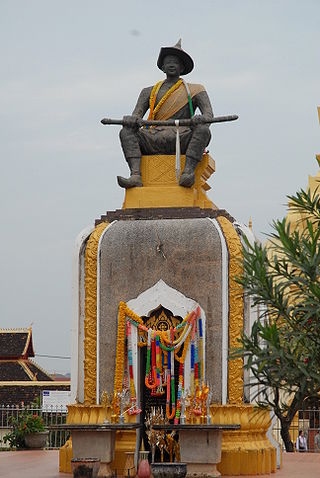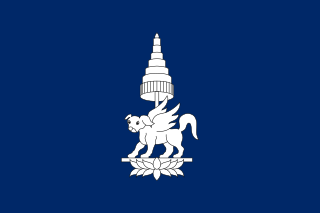
Evidence of modern human presence in the northern and central highlands of Indochina, which constitute the territories of the modern Laotian nation-state, dates back to the Lower Paleolithic. These earliest human migrants are Australo-Melanesians—associated with the Hoabinhian culture—and have populated the highlands and the interior, less accessible regions of Laos and all of Southeast Asia to this day. The subsequent Austroasiatic and Austronesian marine migration waves affected landlocked Laos only marginally, and direct Chinese and Indian cultural contact had a greater impact on the country.

Lan Xang or Lancang was a Lao kingdom that held the area of present-day Laos from 1353 to 1707. For three and a half centuries, Lan Xang was one of the largest kingdoms in Southeast Asia. The kingdom is the basis for Laos's national historic and cultural identity.

Setthathirath or Xaysettha is considered one of the great leaders in Lao history. Throughout the 1560s until his death, he successfully defended his kingdom of Lan Xang against military campaigns of Burmese conqueror Bayinnaung, who had already subdued Xieng Mai in 1558 and Ayutthaya in 1564. Setthathirath was a prolific builder and erected many Buddhist monuments including Wat Xieng Thong in Luang Prabang, Haw Phra Kaew, Wat Ong Teu Mahawihan and the Pha That Luang in Vientiane.

Somdetch Brhat-Anya Fa Ladhuraniya Sri Sadhana Kanayudha Maharaja Brhat Rajadharana Sri Chudhana Negara, better known as Fa Ngum, established the Lao kingdom of Lan Xang in 1353.
Souligna Vongsa was the king of Lan Xang whose reign is considered the golden age of Laos. He ascended to the throne in 1637.

The Kingdom of Champasak or Bassac, (1713–1904) was a Lao kingdom under Nokasad, a grandson of King Sourigna Vongsa, the last king of Lan Xang and son-in-law of the Cambodian King Chey Chettha IV. Bassac and the neighboring principalities of Attapeu and Stung Treng emerged as power centers under what was later to be described as the Mandala Southeast Asian political model.
Nokasad was a grandson of the last king of Lan Xang, King Sourigna Vongsa; and a son-in-law of the Cambodian King Chey Chettha IV. He was made king of the southern Laotian Kingdom of Champasak from 1713 to 1737. In 1718, the first Lao muang in the Chi valley — and indeed anywhere in the interior of the Khorat Plateau — was founded at Suwannaphum District in present-day Roi Et Province by an official in the service of this king. In 1725, he turned his executive powers over to his eldest son; he died at Khorat in 1738.
Setthathirath II, also called Ong Lo and Sai Ong Hue, grandson of the great ruler Suliyavongsa, was the king of the Lao Kingdom of Lān Xāng. In Vietnamese records, he was called Triều Phúc (朝福).

The Burmese–Siamese War (1568–1569) also known as the War of the first fall (สงครามคราวเสียกรุงครั้งที่หนึ่ง) was a military conflict fought between the Kingdom of Ayutthaya (Siam) and the Kingdom of Burma. The war began in 1568 when Ayutthaya unsuccessfully attacked Phitsanulok, a Burmese vassal state. The event was followed by a Burmese intervention which resulted in the 2 August 1569 defeat of Ayutthaya, which became a Burmese vassal state. Burma then moved towards Lan Xang, occupying the country for a short period of time until retreating in 1570.
Chakkaphat Phaen Phaeo (1415–1481) reigned as King of Lan Xang from 1442 to 1480, succeeding the Maha Devi after an interregnum of several years. He was born in 1415 as Prince Vong Buri, the youngest son of King Samsenthai by Queen Nan Keo Yot Fa daughter of King Intharacha of Ayutthaya. When he came of age he was appointed as Governor of Vientiane. He was invited to ascend the throne several times during the succession dispute orchestrated by the Maha Devi, but refused. The Council of Ministers finally persuaded him to become king in 1441, after they had failed to find any other candidate. He still refused to be crowned and avoided the ceremony for many years. Finally bowing to custom in 1456, he was formally coroneted and assumed the reign name and title of Samdach Brhat-Anya Chao Sanaka Chakrapati Raja Phen-Phaeo Bhaya Jayadiya Kabuddha. The regnal name is significant because it translates in Pali to cakkavattin, meaning "Universal Buddhist Monarch." Vong Buri, and the court, were claiming enough political and religious power to unify the kingdom, and warn surrounding kingdoms, despite the upheaval caused by the Maha Devi and interregnum in Lan Xang from 1428-1442.
Souvanna Banlang (1455-1486) was king of Lan Xang from 1479 to 1486 taking the regnal name Samdach Brhat-Anya Chao Suvarna Panya Lankara Raja Sri Sadhana Kanayudha. His reign was marked as a period of peace and reconstruction, following a massive invasion by the Đại Việt forces of Emperor Lê Thánh Tông. He became king in 1479 after the abdication of his father Chakkaphat Phaen Phaeo, who had fled the capital of Muang Sua ahead of the Đại Việt armies. Prior to his accession he served as Governor of Muang Dansai, according to the Lao chronicles he commanded Lao forces at the Battle of Pakphun where the invading forces were halted and forced to retreat to Vietnam.
Sen Soulintha, Saen Surintha or Sen Sourintha (1511–1582) was born Chane Tian and became King of Lan Xang reigning from 1571 to 1575 and again from 1580 to 1582. Sen Soulintha was not of noble birth, rising from royal page to the position of King Setthatirath's Chief Minister. During the succession disputes in the Kingdom of Lan Na between King Setthatirath and King Mekuti, Sen Soulintha served Setthatirath as a general and successfully took several cities of Lan Na including Chiang Saen for which he was given the honorific name Lusai meaning “victory.” Sen Soulintha supported Setthatirath in leading the guerrilla campaigns during the Burmese invasions of King Bayinnaung. When Setthatirath died near Attapeu under suspicious circumstances in 1572, Sen Soulintha led the armies of Lan Xang back to Vientiane. A succession dispute erupted, which nearly led to civil war and provided a pretext for another Burmese invasion ordered by Bayinnaung and led by the Chief Minister Binnya Dala. Sen Soulintha defeated the Burmese and Lan Na forces led by Binnya Dala, an event which led to the latter's exile, only to face a more massive invasion led by Bayinnaug the following year. Sen Soulintha again attempted to resort to guerilla tactics, but lacked popular support from his seizure of the throne. He and his son Ong Lo were captured by Bayinnaung and exiled to Pegu. The Burmese placed Setthathirath's brother, and former Ouphahat or Viceroy, Prince Tha Heua on the throne. According to the Luang Prabang chronicles it was this brother, who had led a rebellion in Luang Prabang and tried to seize the throne from Setthathirath on the death of their father Photisarath. Prince Tha Heua took the regnal name Voravongsa and reigned under Burmese suzerainty from 1575 to 1579. Voravongsa was never popular, and drowned with his family while attempting to flee Vientiane in the face of popular uprising. In 1579, Bayinnaung dispatched a sizable army to restore order. According to Lao histories Sen Soulintha was then installed as king a second time in 1580. By that time Sen Soulintha was an old man and reigned only for two years before his son ascended the throne as Nakhon Noi and another succession dispute ensued.
Voravongsa I was king of Lan Xang reigning from 1575–1579 with the regnal name Samdach Brhat-Anya Chao Brhatasena Vora Varman Raja Sri Sadhana Kanayudha but he is commonly referred to in both Lao and Burmese chronicles by his title of Maha Oupahat or Viceroy. Voravongsa was taken prisoner by the Burmese in 1565 during the occupation of Vientiane. In 1575 following the third of a series of Burmese invasions of Lan Xang, Voravongsa was appointed by Bayinnaung as a vassal within the Taungoo Empire. Voravongsa had few supporters even within the Burmese court; he reigned for only four years before facing a popular rebellion which would threaten to overtake the capital in Vientiane. Voravongsa attempted to flee back to Burma, but were killed en route. To reestablish order the Burmese dispatched another army, and would install Sen Soulintha as vassal from 1580–1582.
Nakhon Noi briefly occupied the throne of Lan Xang from 1582 to 1583 on the death of his father Sen Soulintha, who himself had been appointed as a vassal to the Toungoo Empire from 1580 to 1582. Nakhon Noi took the regnal name Samdach Brhat Chao Samdach Brhat Chao Negara Nawi Raja Sri Sadhana Kanayudha. Little is known about his brief rule, it does not appear in the sources that the Burmese were at the origin of his selection to succeed Sen Soulintha and were instead informed belatedly. If he had supporters in the royal court of Lan Xang they were few and quickly became unhappy with his rule. Within the year the royal court had petitioned King Nanda Bayin for his removal. According to various versions of the chronicles it is cited that Nakhon Noi “did not rule with fairness,” or keep to the religious and behavioral precepts which were traditionally required by a sovereign. Other versions record that he simply had made enemies at court, or was perceived as illegitimate because he was of common origins. Either at the hands of the royal court, or the Burmese, Nakhon Noi was deposed, arrested, and returned to Pegu. After Nakhon Noi was deposed a period of interregnum occurred from 1583 to 1591 which historian Paul Le Boulanger describes as a period of “absolute confusion,” among the factions at court. The chronicles again agree that it was only after the period of succession crisis that a petition was finally sent in 1591 to Nanda Bayin by the Lao sangha and Lan Xang court asking for Prince No Muang, the son and legitimate heir of Setthathirath, to be appointed as king. Nanda Bayin confirmed the request and Prince No Muang would take the throne as Nokeo Koumane and reign Lan Xang from 1591 to 1596.
Mon Keo was the king of the Laotian Kingdom of Lan Xang between 1627 and 1633. Reigning with the regnal name of Samdach Brhat-Anya Chao Manikya Kaeva Raja Sri Sadhana Kanayudha, he was the son of King Voravongsa II and brother of King Ouphagnauvarath I.
Tone Kham was the king of the Laotian Kingdom of Lan Xang between 1633 and 1637. He was the elder son of King Mon Keo.
Vichai was the king of the Kingdom of Lan Xang between 1637 and 1638.
Nan Tharat was a king of Lan Xang who ruled from 1696 to 1698.
Chao Kingkitsarat, also known as Kitsarat or Kitsarath, was the king of Luang Phrabang.





